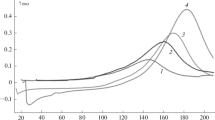Abstract
The quality of modern polymer composite materials and composite-based structures is largely determined by technological conditions of their production. The paper deals with the optimization of technological conditions of heat treatment of cured composite products, carried out based on the results of mathematical and computer modelling of thermochemical and thermophysical properties of materials, as well as heat transfer processes accompanied by corresponding physical and chemical transformations in the product. The results of the studies and subsequent mathematical modelling of shrinkage of the epoxy binder EA9396 during curing are presented. The experimental data are obtained using the differential scanning calorimetry. An analytical dependence describing the change in the degree of curing of a binder with a change in the conditions of product moulding has been proposed. The dependence makes it possible to determine the state of a polymer binder (viscous, viscoelastic, elastic) at any time of the curing process, to establish the point at which stresses occur in the cured structure as well as to detect the physical and mechanical properties of the composite corresponding to the degree of curing and viscosity. A model of polymer binder shrinkage during curing has been developed. The shrinkage model satisfactorily describes the experimental results. The curves constructed using the experimentally received reaction rate data and the analytical model differ by no more than 5%. The dependence of the shrinkage rate of the polymer binder on the reaction rate is presented. A software that allows obtaining the dependence of the degree of curing and shrinkage on time for a given temperature range has been developed. Based on the results received, the selection of the optimal curing mode can be carried out, which makes it possible to compensate shrinkage deformations with temperature ones and reduce technological stresses in the composite product.
Access this chapter
Tax calculation will be finalised at checkout
Purchases are for personal use only
Similar content being viewed by others
References
Karpus, V., Ivanov, V., Dehtiarov, I., Zajac, J., Kurochkina, V.: Technological assurance of complex parts manufacturing. In: Advances in Design, Simulation and Manufacturing. DSMIE 2018. Lecture Notes in Mechanical Engineering, pp. 51–61. Springer, Cham (2019). https://doi.org/10.1007/978-3-319-93587-4_6
Otrosh, Y., Kovalov, A., Semkiv, O., Rudeshko, I., Diven, V.: Methodology remaining lifetime determination of the building structures. In: MATEC Web Conferences 2018, vol. 230, p. 02023 (2018). https://doi.org/10.1051/matecconf/201823002023
Fomin, O., Lovskaya, A., Plakhtiy, A., Nerubatsky, V.: The influence of implementation of circular pipes in load-bearing structures of bodies of freight cars on their physico-mechanical properties 6(162), 89–96 (2017)
Galych, I., Antoshchenkov, R., Antoshchenkov, V., Lukjanov, I., Diundik, S., Kis, O.: Estimating the dynamics of a machine-tractor assembly considering the effect of the supporting surface profile. Eastern-Eur. J. Enterp. Technol. 1(7(109), 51–62 (2021). https://doi.org/10.15587/1729-4061.2021.225117
Smetankina, N., Merkulova, A., Merkulov, D., Postnyi, O.: Dynamic response of laminate composite shells with complex shape under low-velocity impact. In: International Scientific and Technical Conference on Integrated Computer Technologies in Mechanical Engineering - Synergetic Engineering, ICTM 2020, vol. 188, pp. 267–276 (2021). https://doi.org/10.1007/978-3-030-66717-7_22
Slyvynskyi, V.I., Sanin, A.F., Kharchenko, M.E., Kondratyev, A.V.: Thermally and dimensionally stable structures of carbon-carbon laminated composites for space applications. In: 65th International Astronautical Congress 2014, IAC 2014, vol. 8, pp. 5739–5751 (2014)
Rajak, D.K., Pagar, D.D., Menezes, P.L., Linul, E.: Fiber-reinforced polymer composites: manufacturing, properties, and applications. Polymers 11(10), 1667 (2019). https://doi.org/10.3390/polym11101667
Rodionov, V.V.: Optimization of molding the polymeric composite material with improved characteristics. Plast. Massy 3–4, 55–58 (2019). https://doi.org/10.35164/0554-2901-2019-3-4-55-58
Saba, N., Jawaid, M.: A review on thermomechanical properties of polymers and fibers reinforced polymer composites. J. Ind. Eng. Chem. 67, 1–11 (2018). https://doi.org/10.1016/j.jiec.2018.06.018
Tiwary, A., Kumar, R., Chohan, J.S.: A review on characteristics of composite and advanced materials used for aerospace applications. Mater. Today Proc. 51(1), 865–870 (2022). https://doi.org/10.1016/j.matpr.2021.06.276
Hsissou, R., Seghiri, R., Benzekri, Z., Hilali, M., Rafik, M., Elharfi, A.: Polymer composite materials: a comprehensive review. Compos. Struct. 262, 113640 (2021). https://doi.org/10.1016/j.compstruct.2021.113640
Gaidachuk, V.E., Kondratiev, A.V., Chesnokov, A.V.: Changes in the thermal and dimensional stability of the structure of a polymer composite after carbonization. Mech. Compos. Mater. 52(6), 799–806 (2017). https://doi.org/10.1007/s11029-017-9631-6
Kombarov, V., Kryzhyvets, Y., Biletskyi, I., Tsegelnyk, Y., Aksonov, Y., Piddubna, L.: Numerical control of fiberglass pipe bends manufacturing. In: IEEE 2nd KhPI Week on Advanced Technology 2021, pp. 357–362 (2021). https://doi.org/10.1109/KhPIWeek53812.2021.9570068
Li, D.N., Li, X.D., Dai, J.F., Xi, S.B.: A comparison of curing process-induced residual stresses and cure shrinkage in micro-scale composite structures with different constitutive laws. Appl. Compos. Mater. 25, 67–84 (2018). https://doi.org/10.1007/s10443-017-9608-6
Yuan, Z.Y., Wang, Y.J., Yang, G.G., Tang, A.F., Yang, Z.C., Li, S.J., Li, Y., Song, D.L.: Evolution of curing residual stresses in composite using multi-scale method. Compos. Part B-Eng. 155, 49–61 (2018). https://doi.org/10.1016/j.compositesb.2018.08.012
Carlone, P., Rubino, F., Paradiso, V., Tucci, F.: Multi-scale modeling and online monitoring of resin flow through dual-scale textiles in liquid composite molding processes. Int. J. Adv. Manuf. Technol. 96, 2215–2230 (2018). https://doi.org/10.1007/s00170-018-1703-9
Lionetto, F., Moscatello, A., Totaro, G., Raffone, M., Maffezzoli, A.: Experimental and numerical study of vacuum resin infusion of stiffened carbon fiber reinforced panels. Materials 13(21) (2020). https://doi.org/10.3390/ma13214800
Rocha, H., Semprimoschnig, C., Nunes, J.P.: Sensors for process and structural health monitoring of aerospace composites: a review. Eng. Struct. 237, 112231 (2021). https://doi.org/10.1016/j.engstruct.2021.112231
Brauner, C., Frerich, T., Herrmann, A.S.: Cure-dependent thermomechanical modelling of the stress relaxation behaviour of composite materials during manufacturing. J. Compos. Mater. 51, 877–898 (2017). https://doi.org/10.1177/0021998316656924
Cameron, C.J., Saseendran, S., Stig, F., Rouhi, M.: A rapid method for simulating residual stress to enable optimization against cure induced distortion. J. Compos. Mater. 55(26), 3799–3812 (2021). https://doi.org/10.1177/00219983211024341
Muliana, A.H.: Spatial and temporal changes in physical properties of epoxy during curing and their effects on the residual stresses and properties of cured epoxy and composites. Appl. Eng. Sci. 7, 100061 (2021). https://doi.org/10.1016/j.apples.2021.100061
Kondratiev, A., Píštěk, V., Smovziuk, L., Shevtsova, M., Fomina, A., Kučera, P.: Stress–strain behaviour of reparable composite panel with step–variable thickness. Polymers 13(21), 3830 (2021). https://doi.org/10.3390/polym13213830
Startsev, O.V., Vapirov, Y.M., Lebedev, M.P., Kychkin, A.K.: Comparison of glass-transition temperatures for epoxy polymers obtained by methods of thermal analysis. Mech. Compos. Mater. 56(2), 227–240 (2020). https://doi.org/10.1007/s11029-020-09875-5
Deng, B., Shi, Y.Y., Yu, T., Zhao, P.: Influence mechanism and optimization analysis of technological parameters for the composite prepreg tape winding process. Polymers 12(8), 1843 (2020). https://doi.org/10.3390/polym12081843
Budelmann, D., Schmidt, C., Meiners, D.: Prepreg tack: a review of mechanisms, measurement, and manufacturing implication. Polym. Compos. 41(9), 3440–3458 (2020). https://doi.org/10.1002/pc.25642
Brinson, H.F., Brinson, L.C.: Polymer Engineering Science and Viscoelasticity: An Introduction, 2nd edn., p. 482. Springer (2015). https://doi.org/10.1007/978-1-4899-7485-3
Baran, I., Cinar, K., Ersoy, N., Akkerman, R., Hattel, J.H.: A review on the mechanical modeling of composite manufacturing processes. Arch. Comput. Methods Eng. 24, 365–395 (2017). https://doi.org/10.1007/s11831-016-9167-2
Shah, V.: Handbook of Plastics Testing and Failure Analysis, 4th edn. Wiley, Hoboken (2020)
Author information
Authors and Affiliations
Corresponding author
Editor information
Editors and Affiliations
Rights and permissions
Copyright information
© 2023 The Author(s), under exclusive license to Springer Nature Switzerland AG
About this paper
Cite this paper
Kondratiev, A., Shevtsova, M., Vambol, O., Tsaritsynskyi, A., Nabokina, T. (2023). Modelling Shrinkage of a Polymer Binder During Curing. In: Shkarlet, S., et al. Mathematical Modeling and Simulation of Systems. MODS 2022. Lecture Notes in Networks and Systems, vol 667. Springer, Cham. https://doi.org/10.1007/978-3-031-30251-0_6
Download citation
DOI: https://doi.org/10.1007/978-3-031-30251-0_6
Published:
Publisher Name: Springer, Cham
Print ISBN: 978-3-031-30250-3
Online ISBN: 978-3-031-30251-0
eBook Packages: EngineeringEngineering (R0)




